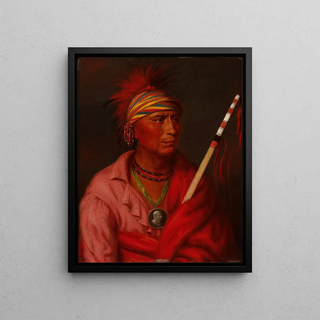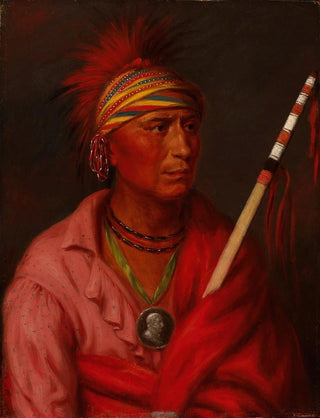Art print | Pas de cœur Nan-che-ning-ga - George Catlin


View from behind

Frame (optional)
In the rich and captivating universe of art, some works transcend mere visuals to become witnesses of an era, a culture. "Pas de cœur Nan-che-ning-ga" by George Catlin is one of these iconic pieces. Created in the 19th century, this art print transports the viewer to the heart of Native American traditions, revealing the depth of rituals and beliefs that shaped tribal life. By contemplating this art print, one is invited to dive into a world where every detail matters, where each color tells a story. Catlin, a true pioneer, immortalized scenes of daily life and sacred ceremonies, offering a valuable glimpse into a often little-known culture.
Style and uniqueness of the work
Catlin's style is distinguished by its ability to combine realism and expressiveness. In "Pas de cœur Nan-che-ning-ga," the characters are depicted with striking accuracy, each facial trait conveying deep emotions. The use of colors, both vivid and nuanced, gives the scene a vibrant and immersive atmosphere. Catlin does not merely reproduce human figures; he captures the very essence of their existence. The motifs and symbols present in the work testify to meticulous research, a desire to honor the traditions of the peoples he encountered. This art print is not limited to simple representation; it becomes a window into a world rich in history and spirituality.
The artist and his influence
George Catlin, artist and ethnographer, dedicated a significant part of his life to documenting Native American cultures. His work is not limited to mere artistic interest; it is the result of a passionate quest for understanding and respect for the peoples he met. Catlin traveled across the United States, capturing the diversity of tribes and their ways of life. His work had a considerable influence on how Native Americans are perceived in art and popular culture. By highlighting their traditions, he contributed to a collective awareness of the need to preserve these cultures in the face of colonial expansion. Thus, "Pas de cœur Nan

Matte finish

View from behind

Frame (optional)
In the rich and captivating universe of art, some works transcend mere visuals to become witnesses of an era, a culture. "Pas de cœur Nan-che-ning-ga" by George Catlin is one of these iconic pieces. Created in the 19th century, this art print transports the viewer to the heart of Native American traditions, revealing the depth of rituals and beliefs that shaped tribal life. By contemplating this art print, one is invited to dive into a world where every detail matters, where each color tells a story. Catlin, a true pioneer, immortalized scenes of daily life and sacred ceremonies, offering a valuable glimpse into a often little-known culture.
Style and uniqueness of the work
Catlin's style is distinguished by its ability to combine realism and expressiveness. In "Pas de cœur Nan-che-ning-ga," the characters are depicted with striking accuracy, each facial trait conveying deep emotions. The use of colors, both vivid and nuanced, gives the scene a vibrant and immersive atmosphere. Catlin does not merely reproduce human figures; he captures the very essence of their existence. The motifs and symbols present in the work testify to meticulous research, a desire to honor the traditions of the peoples he encountered. This art print is not limited to simple representation; it becomes a window into a world rich in history and spirituality.
The artist and his influence
George Catlin, artist and ethnographer, dedicated a significant part of his life to documenting Native American cultures. His work is not limited to mere artistic interest; it is the result of a passionate quest for understanding and respect for the peoples he met. Catlin traveled across the United States, capturing the diversity of tribes and their ways of life. His work had a considerable influence on how Native Americans are perceived in art and popular culture. By highlighting their traditions, he contributed to a collective awareness of the need to preserve these cultures in the face of colonial expansion. Thus, "Pas de cœur Nan






